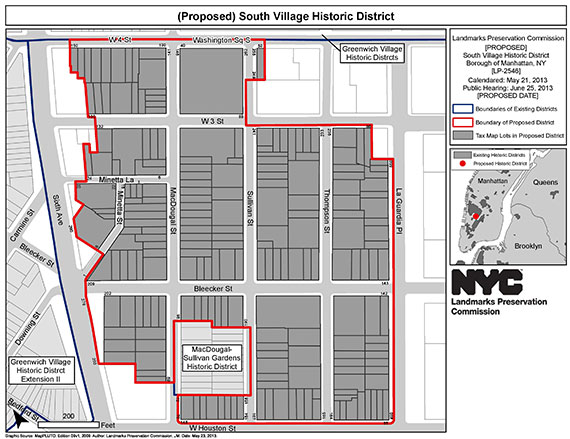The designation of the new South Village Historic District on Tuesday is cause for major celebration. And that’s just what preservationists and neighborhood activists did later that evening at Poisson Rouge, on Bleecker St., right in the heart of the newly created landmarked district — the designation having gone into effect immediately upon the Landmarks Preservation Commission’s unanimous vote a few hours earlier.
The victory party was well deserved. This was the culmination of a 10-year campaign — though the struggle isn’t quite yet finished.
Fittingly, the fete’s location was rich with history in and of itself. The building in whose basement the club is located was once known as Mills House No. 1. It was built as a place for down-and-out men to recover. With an exterior that juts in and out, offering lots of window space, it was designed to offer healthy ventilation to its rooms’ occupants. Later on, its basement became home to Art D’Lugoff’s legendary Village Gate, where so many legendary jazz and folk musicians and standup comics performed.
That this district wasn’t landmarked before is puzzling, since it’s really the area that many people associate with Greenwich Village.
Who knows why it wasn’t landmarked with the rest of the Greenwich Village Historic District in 1969. Maybe because its residents weren’t as affluent as those to the north? Possibly because its architecture, while grand in its own way, was different from the elegant townhouses, for example, that ring Washington Square? Whatever the reason, this designation was long overdue.
The area has seen sudden demolitions of historically significant properties, such as, this summer, 186 Spring St., a building that was a hotbed of early gay rights activism. Another demolition, at 178 Bleecker St., in 2009, was equally jarring. Both sites remain vacant holes today.
Despite this week’s victory, preservationists, residents and local politicians are not taking a moment’s pause, since Phase III of the Greenwich Village Society for Historic Preservation’s original South Village Historic District proposal is still unlandmarked. L.P.C. has said it will survey this area, but it’s unquestionably a stock of buildings worthy of protecting.
This unprotected area includes St. Anthony’s Church, on Sullivan St., America’s oldest surviving and still-functioning Italian-American church. Another noteworthy feature of this third and final district is a group of tenement buildings, scattered along Thompson and Sullivan Sts., built in the early 1900s by the Citizens Investment Corporation, an Italian-American group, to house working-class, immigrant families. Interestingly, these buildings all sport glazed white-brick facades, a style that became popular decades later in the 1960s for luxury high-rise apartment buildings.
And the district is facing serious encroachment by new development, such as just east of the former Tunnel Garage site (which is now occupied by luxury condos) by a new 16-story residential tower. A variance for this project to allow it to go forward, in fact, was just approved by the city’s Board of Standards and Appeals.
At MacDougal St. at King St., a townhouse was recently suddenly razed, leaving another “empty tooth” in the landscape.
And now word has it that developer / newspaper publisher Jared Kushner is buying up properties around St. Anthony’s Church, including the former Joe Dairy’s building. Currently, there’s nothing stopping a developer from razing a swath of buildings for a new tower.
We hope that under new Mayor Bill de Blasio, this culturally and historically significant and world-famous area is recognized as such, and designated A.S.A.P., before more irreparable damage is done.
In the meantime, much congratulations to G.V.S.H.P. and the Villagers who fought so long and hard to win this latest designation. More power to you — and let’s keep up the pressure for Phase III!







































